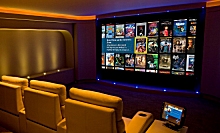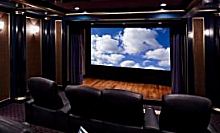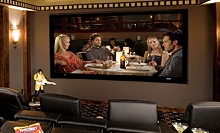s A 7.1 surround sound system is used in the majority of home theaters. This includes one seven channel speakers which are two rear surrounds, two side surrounds, and a right and left surround as well as subwoofer. The electrical contractor will identify the location of where each speaker will be located in order to prewire the 7.1 surround sound system. These locations are the rear surrounds that will be located on the back wall and the individual system will determine just how far apart they should be, the side surrounds on the walls immediately behind the primary row of seating, right/left at ear height on both sides of the screen, and the center surround just below or above the viewing screen.
The electrical contractor will select a location for your audio/video equipment such as the hub that will house your receiver. This hub can be hidden in a nearby closet or in a cabinet within the theater. The electrical contractor will then run cables between each speaker location and the hub. The cables need to be four conductor, 16 gauge or 16-4 at a minimum for the rear and side speakers. For the center, right, and left speakers, a stronger 12 or 14 gauge cables should be used.














